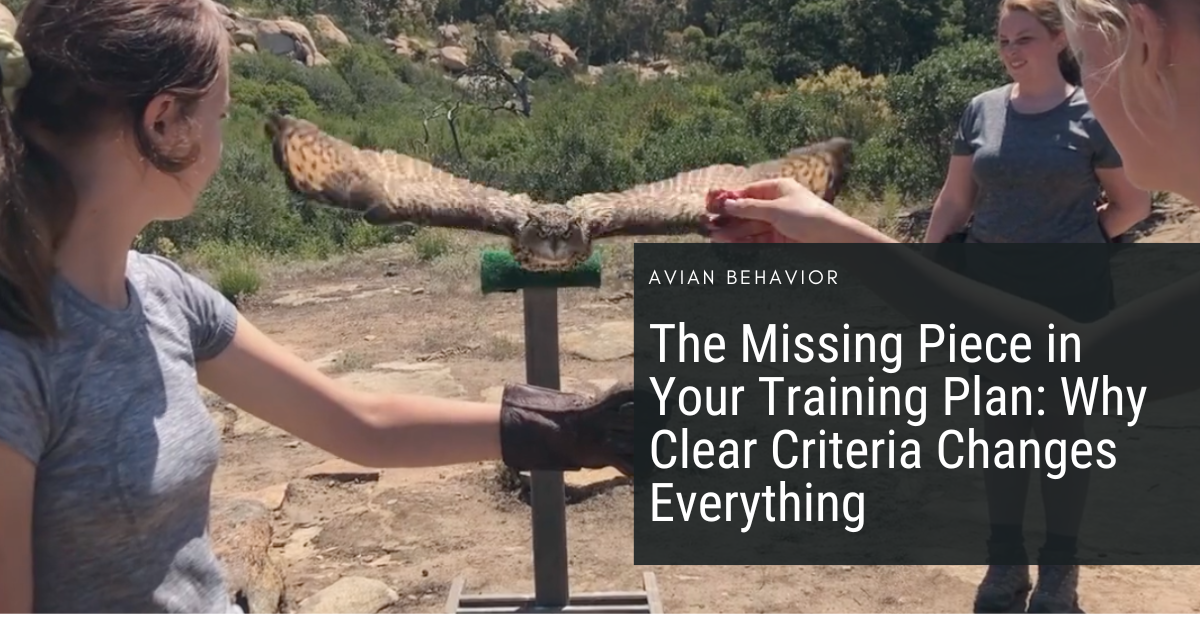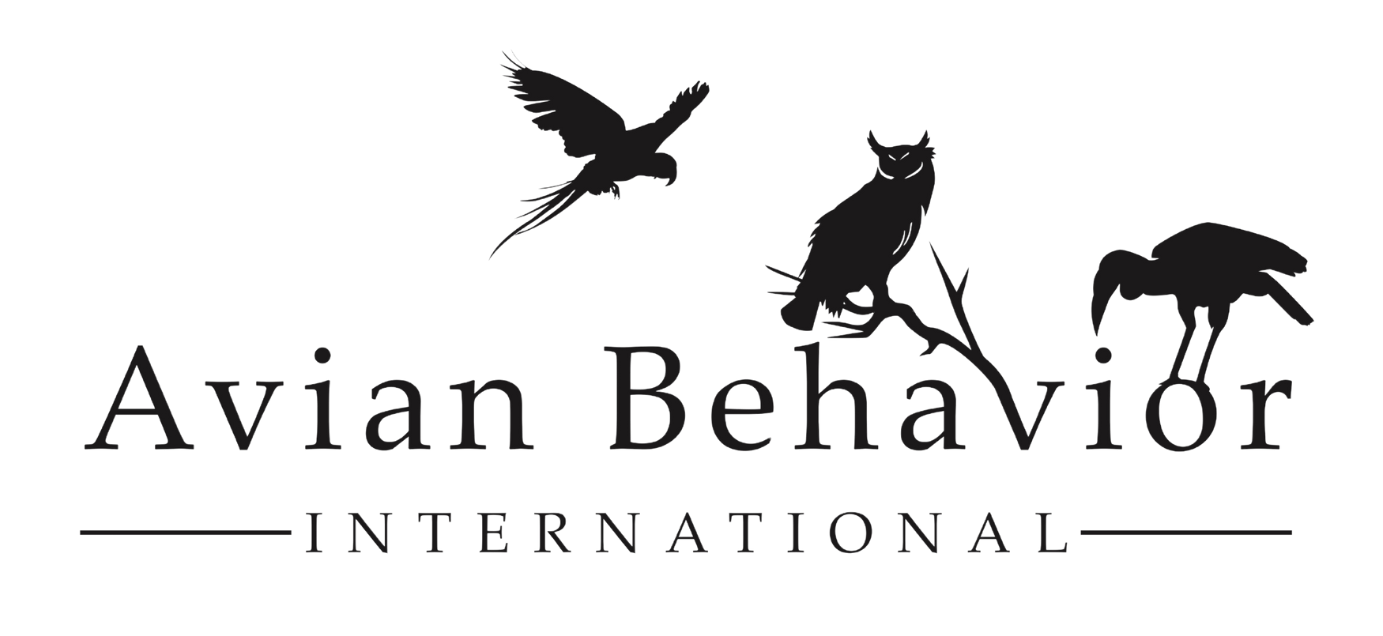
07 Nov The Missing Piece in Your Training Plan: Why Clear Criteria Changes Everything
If you’ve ever found yourself stuck in a training session thinking “why isn’t this working?”, the answer might not be your mechanics, your timing, or even your reinforcer. It might be that you never clearly defined what you’re actually training for.
Let’s talk about why clarity creates success and how defining proper goals and criteria can transform your training outcomes.
The Problem We Don’t Always See
Picture this: You’re working with a bird that won’t step up reliably. Or one that bails back into the crate as soon as it gets the chance. Maybe you’ve got a screech owl doing that awkward frozen posture with their neck practically over their tail, or a burrowing owl who just decides today is not the day to come out.
Your first instinct might be to work on “the problem” — fix the biting, stop the refusal, eliminate the stress response.
But here’s what we often miss: The problem we need to solve isn’t always the problem we see.
Sometimes the issue isn’t the step-up behavior itself. It’s that the bird doesn’t have a strong enough foundation. Or our mechanics need work. Or we haven’t built sufficient reinforcement value yet.
And often, it’s because we’re trying to train something we haven’t clearly defined.
Terminal Behavior: What Does Success Actually Look Like?
Before you pick up a target stick or open a bait bag, ask yourself: What does the full behavior look like from start to finish?
Not in your head. Not as a vague concept. But as something:
- Observable — You can see it happening
- Repeatable — The bird can do it consistently
- Reinforceable — You can mark and reward it clearly
Here’s the difference:
❌ Vague: “I want a calm bird”
✅ Clear: “Bird approaches the glove, steps on with both feet, maintains relaxed body posture for 3 seconds”
❌ Vague: “Get the bird comfortable with crating”
✅ Clear: “Bird steps into crate opening, pauses, moves fully inside, turns around to face opening”
See how the second version gives you something concrete to work toward? That’s your terminal behavior, the complete picture of success.
Criteria: The Reinforcement Rule
Now here’s where most of us get fuzzy: What exactly earns reinforcement at each stage?
That’s your criteria. And good criteria are:
- Observable — “Bird looks at glove” not “bird seems interested”
- Measurable — “Holds foot on perch for 2 seconds” not “holds foot for a while”
- Achievable at that stage — Not asking for the full behavior when you’re still on step two
Too vague = frustration and drift. You end up randomly reinforcing, and the bird never quite knows what you’re asking for.
A Real Example: Voluntary Nail Trim
Let’s break down how this looks in practice.
Terminal behavior: Foot offered calmly to perch for nail file contact and trimming
Shaping steps:
- Bird approaches station
- Bird touches perch with foot
- Bird holds foot on perch for 2 seconds
- Bird allows nail file to approach
- Gradually increase duration of contact
Each step has clear criteria. You’re not “waiting for it to happen” — you’re systematically building toward the goal by reinforcing approximations.
If you’re stuck, your slice is too big. Go smaller.
When Food Isn’t an Option: Using Distance as the Reinforcer
Here’s where it gets interesting for those of us working with rehab birds, fearful birds, or birds who just won’t eat in training contexts.
Distance can be your reinforcer.
We had an eastern screech owl whose trainer thought taking him on walks around the property was enriching. Turns out, the bird was being put in a state of fear — too much open space, not enough tree cover. Eventually, he started dive-bombing her when she came to weigh him.
So we had to repair their relationship. And we did it by reinforcing calm behavior with distance.
How It Worked:
- Trainer approaches the mew
- Screech owl chitters (not pleased to see her)
- She immediately steps back — that’s the reinforcement
- She waits for him to stop chittering
- When he’s calm, she moves closer again
- Repeat
She also put food down, but he wasn’t taking it. That’s okay. Distance was the functional consequence — that’s what he actually wanted.
Over time, as he learned the pattern (she’ll leave when I’m calm, not when I’m upset), he started to relax. And eventually, he started taking food too.
That’s the paradox of using negative reinforcement well: once the bird understands you’re listening, positive reinforcement becomes more salient.
Another Example: The Rough-Legged Hawks
We had two rough-legged hawks in a five-day training program. Willow, the one we focused on, was not comfortable around people.
Day 2: Trainer used tap targets to get close, then intentionally moved her body away when Willow showed calm behavior. She’d put her glove up, then bring it down — classic negative reinforcement (pressure on, pressure off). She paired it with food, but also with actually leaving the session to give the bird a break.
Day 5: By the end of the program, Willow was leaning toward the glove. Eventually stepped up. The trainer didn’t trap her — she left her right by the perch.
What changed? Willow learned the pattern. “Oh, you’re not going to keep pressuring me with the glove. You actually listen.”
Once she got that, she became more interested in food and less interested in accessing distance.
The Bigger Picture: Why This Matters
When we use clear goals and criteria — when we understand what we’re reinforcing and why — we’re not just training behaviors. We’re:
- Reducing stress indicators (panting, baiting, open mouth, gular fluttering)
- Improving safety (fewer bites, lunges, beats)
- Building authentic relationships that audiences can see
- Creating long-term resilience and reliability in our birds
- Reducing trainer burnout because the work becomes collaborative, not combative
We’re building cooperation, not compliance.
And that cooperation is built on clear communication — which starts with knowing exactly what we’re asking for.
Training is Not Linear
One last thing: Expect variability.
Your bird isn’t going to progress in a straight line. Some days they’ll nail it. Some days they’ll regress. That’s normal.
Fluency before complexity. Make sure the bird is solid at one step before you add the next challenge.
And if you’re stuck? Your criteria might be too vague, or your shaping slice might be too big. Go smaller. Get clearer.
Behavior science doesn’t come easily or happen overnight. Your learning as a trainer happens in small approximations too, just like your bird’s.
Your Turn
Take a behavior you’re currently working on. Ask yourself:
- What’s my terminal behavior? (Can I describe it clearly enough that someone else could recognize it?)
- What are my criteria at this stage? (What specifically earns reinforcement right now?)
- Am I trying to fix a problem, or build a skill? (Constructional vs. pathological approach)
- What does my bird actually find reinforcing? (Food? Distance? Something else?)
If you can answer those four questions clearly, you’re already ahead of the game.
This lesson is part of the Fundamentals of Progressive, Choice-Based Animal Training course available to Avian Behavior Lab members. Want more in-depth training on shaping, criteria-setting, and building choice-based programs? Join the Avian Behavior Lab – Free for 2 weeks. Use code: AVIAN at checkout.

